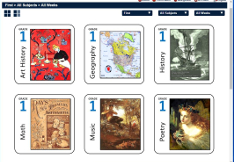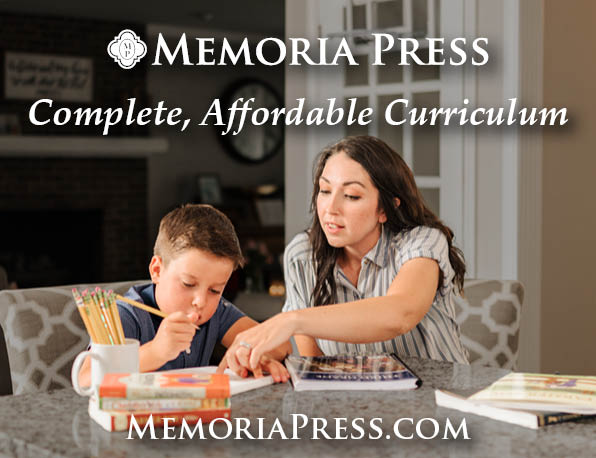Under the Home (UTH) is a complete online curriculum available for kindergarten through fifth grade. There is coursework for 36 weeks per year in math, reading, prose, poetry, writing, art history, music, and studio art. History, geography, and science are added for first grade and above.
It is important to note that this curriculum is free! One reason the author is able to do this is by utilizing many older textbooks and resources that are in the public domain. UTH creator Sonja Glumich has greatly enhanced these resources with detailed lesson plans that include teaching instructions, questions, and a wealth of activities. All course material is on the ad-free UTH website, so there are no worries about dead links, surfing to objectionable pages, or the interference of advertising.
While the source textbooks used for math and reading are traditional in their approach, lesson guides broaden the appeal of those books and make lessons workable for the many children who need additional methods of learning.
For kindergarten math, UTH borrows methods for teaching number concepts and basic arithmetic from an 1885 book, The Eclectic Manual of Methods. However, UTH lessons add some hands-on activities. Children might continue with these lessons into first grade if need be. When students have completed them, they should be ready for Ray’s New Primary Arithmetic which is used next. UTH continues to add hands-on activities for Ray’s Arithmetic. Other books from the Ray's series are used for higher grades.
For reading instruction for kindergarten through second grade, UTH has two strands, both of which will be followed with all students. One strand teaches explicit phonics, while the other teaches broader reading skills. Children will need to begin with phonics lessons before they are ready to begin the reading lessons since the first reading lesson for kindergarten teaches the sounds and recognition of six letters plus the upper-case A as well as the words A, a, cat, rat, and and. This presupposes that children already have some familiarity with the alphabet and sounds and are ready to blend letters into words. For reading skills, UTH enhances McGuffey’s Eclectic Primer with guides for teaching each lesson plus online audio pronunciation of letters, words, and sentences. The McGuffey Readers continue to be used beyond second grade.
Handwriting lessons in kindergarten begin with printable pages from either a tracework book or a copywork book. Both use material from McGuffey’s Eclectic Primer. Links to the copywork pages are embedded in the correlating reading lessons. If children have not already learned to print, you will probably have to provide more direct instruction on the formation of individual letters than is provided here. There is no instruction in cursive handwriting included at this time.
Charlotte Mason’s ideas have definitely influenced UTH. The studies for art, literature, prose, and poetry expose children to authors, artists, and composers along with their works in a Charlotte Mason fashion. Lesson plans always include narrations and picture studies, but they also sometimes add background material to be read by the parent and other activities, such as learning vocabulary words, coloring, drawing, identifying map locations, and acting.
Prose lessons use real books that are included on UTH’s site. For kindergarten, children will listen to My Father’s Dragon, stories from The Great Big Treasury of Beatrix Potter, Raggedy Ann Stories, Raggedy Andy Stories, The Velveteen Rabbit, and Uncle Wiggily’s Adventures. First graders listen to The Story of Dr. Doolittle, The Wind in the Willows, and The Princess and the Goblin. Second graders hear The Wonderful World of Oz, Alice in Wonderland, and Pinocchio. Third graders listen to stories and tales from around the world and child-friendly versions of some of Shakespeare's plays. For fourth grade, students Treasure Island, A Christmas Carol, King Arthur and His Knights (by Radford), and Old Greek Stories. Fifth graders will read Tom Sawyer, Rebecca of Sunnybrook Farm, and a selection of short stories. These public domain literary works have free audio narrations, courtesy of LibriVox, and the audio narrations are linked within each lesson. Parents can read books aloud, have children read books themselves, or use the audio narrations. Both the stories and the audio narrations are presented in segments for each lesson, so there’s no problem finding your place to pick up the next day. Discussion questions, vocabulary, and other activities gradually expand as you progress through the grade levels.
Poetry lessons use Mother Goose poems for kindergarten then Poetry of Fables, Fairies, and Fauna for first grade. Poetry lessons each include both a lesson guide and an audio narration. Lesson guides add other activities such as memorizing and reciting poems, studying a picture that illustrates the poem, coloring, and completing a related art project. Poetry activities in the lesson guides become more diverse as children progress. By third grade, for example, students read a poem by Emily Dickinson, learn about her, study a picture that illustrates the poem, recite the poem, complete a vocabulary exercise, write a summary of the poem, copy an excerpt from the poem, write that same excerpt from dictation, and draw an illustration. Even more optional activities are included for this same poem. Poetry study continues through all grade levels.
Children learn about classical composers and their works in the music lessons, and the composers' music is embedded in the UTH website. Art history lessons concentrate on particular artists each year and study some of their representative works. Additional background information and enrichment activities turn both music and art history lessons into mini-unit studies.
Poetry, art, and music lessons often intermix activities. For example, a music lesson on Beethoven’s “A Hymn of Thanksgiving” has children listen to the music a number of times. Children try to describe the music and what they heard. They discuss thankfulness and come up with their own examples. They are to color, draw, or sketch one or more things for which they are grateful while listening to the music. They study a painting showing food and resources that might be involved in preparing for Thanksgiving, narrating what they see and how it might relate to the music. I love this integrated approach.
Studio Art lessons are art activities with complete instructions. You will need to obtain your own art supplies such as pens, pencils, crayons, markers, drawing paper, colored paper, washable acrylic paints, polymer clay, and Play-Doh. Second and third graders learn to draw with The New Augsburg's Drawing First Year Book and Second Year Book respectively.
Science for first grade uses Peter and Polly in Autumn by Rose Lucia, part of an older series that teaches about nature through stories of two young children who live on a farm in the early 1900s. UTH has created extensive lessons for the readings from this book. Lessons include narration by your child, summaries of key ideas, leading questions for parents to use, and additional activities to support learning such as experiments, nature sketching, and observations. Second- through fifth-grade science courses present nature studies using older fiction and non-fiction books. Students will take nature walks and create a field journal.
Geography for first grade begins with the study of a child's home and neighborhood then moves out to the broader world covering topics such as types of streets, libraries, museums, railroads, original inhabitants, slavery, manufacturing, transporting products, plants, hills, and plains. Children should create their own notebooks as they will be observing, drawing, and maybe writing about what they see and experience in many of the lessons. Second graders learn broad geography concepts such as geographical features, cardinal directions, and map reading. Third grade incorporates some earth and space science into geography as students learn about topics such as the water cycle, weather, compasses, seasons, and plant life.
History begins in first grade with Stories of Great Americans for Little Americans by Edward Eggleston. As with other subject areas, the lesson guides, copywork, coloring pages, and a variety of learning activities expand the stories into a full course. Second graders study ancient civilizations in the Middle East. Third graders study world history from the Fall of the Roman Empire up through the Crusades using the first half of Van Loon's The Story of Mankind. Fourth graders continue with world history through the early 20th century, and fifth graders study U.S. history with Eggleston's A History of the United States and Its People and a collection of stories.
A parent needs to work through the lessons with each child, although there are some lesson activities that children can complete on their own. This is not an independent study curriculum. For most lessons, there are two tabs labeled Lesson and Lesson Guide. Under the Lesson tab is where you find the course material—book, artwork, poetry, etc. The parent simultaneously needs to be able to follow the Lesson Guide while presenting the lessons. While this might pose a potential problem, I found that I could access the lessons on two different devices at the same time with the same login. So if you want the child to be able to view, for example, an image of a painting for art history or a math lesson while you teach the lesson—which seems essential to me, the child would need to be logged in simultaneously on another device.
Summary
Other publishers besides Under the Home have created programs using older resources with mixed results. There are drawbacks to using dated material: maybe your children won’t relate to the stories of children living on farms, or maybe they won’t like the illustrations. Also, older textbooks present material in ways that might be very different in sequence, style, and vocabulary than modern resources.
UTH overcomes some of the negatives associated with using older resources because their lesson guides do a lovely job of applying Charlotte Mason and unit study methodology alongside the older resources. Looking through the geography lessons for first grade, I found myself thinking that the activities were surely more interesting and effective for learning than most modern social studies textbooks for first grade.
If you like the style of lesson presentation for some subjects and not others, you can always use only those you prefer. Even if you use lessons for only one or two subjects in a year, there's no cost.
UTH is super easy to navigate. You can use lessons from each subject area in sequence or not as you please. However, the program does not track progress or maintain any records. While parents will need to gather hands-on resources for some lessons, that shouldn't be very time consuming or challenging. Overall, Under the Home offers a surprisingly sophisticated, free, and easy-to-use option for homeschooling.









